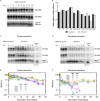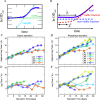Distinct Survival, Growth Lag, and rRNA Degradation Kinetics during Long-Term Starvation for Carbon or Phosphate
- PMID: 35440180
- PMCID: PMC9241543
- DOI: 10.1128/msphere.01006-21
Distinct Survival, Growth Lag, and rRNA Degradation Kinetics during Long-Term Starvation for Carbon or Phosphate
Abstract
The stationary phase is the general term for the state a bacterial culture reaches when no further increase in cell mass occurs due to exhaustion of nutrients in the growth medium. Depending on the type of nutrient that is first depleted, the metabolic state of the stationary phase cells may vary greatly, and the subsistence strategies that best support cell survival may differ. As ribosomes play a central role in bacterial growth and energy expenditure, ribosome preservation is a key element of such strategies. To investigate the degree of ribosome preservation during long-term starvation, we compared the dynamics of rRNA levels of carbon-starved and phosphorus-starved Escherichia coli cultures for up to 28 days. The starved cultures' contents of full-length 16S and 23S rRNA decreased as the starvation proceeded in both cases, and phosphorus starvation resulted in much more rapid rRNA degradation than carbon starvation. Bacterial survival and regrowth kinetics were also quantified. Upon replenishment of the nutrient in question, carbon-starved cells resumed growth faster than cells starved for phosphate for the equivalent amount of time, and for both conditions, the lag time increased with the starvation time. While these results are in accordance with the hypothesis that cells with a larger ribosome pool recover more readily upon replenishment of nutrients, we also observed that the lag time kept increasing with increasing starvation time, also when the amount of rRNA per viable cell remained constant, highlighting that lag time is not a simple function of ribosome content under long-term starvation conditions. IMPORTANCE The exponential growth of bacterial populations is punctuated by long or short periods of starvation lasting from the point of nutrient exhaustion until nutrients are replenished. To understand the consequences of long-term starvation for Escherichia coli cells, we performed month-long carbon and phosphorus starvation experiments and measured three key phenotypes of the cultures, namely, the survival of the cells, the time needed for them to resume growth after nutrient replenishment, and the levels of intact rRNA preserved in the cultures. The starved cultures' concentration of rRNA dropped with starvation time, as did cell survival, while the lag time needed for regrowth increased. While all three phenotypes were more severely affected during starvation for phosphorus than for carbon, our results demonstrate that neither survival nor lag time is correlated with ribosome content in a straightforward manner.
Keywords: Escherichia coli; bacterial stress response; lag time; nutrient starvation; ribosomal RNA; stable RNA degradation; stationary phase.
Conflict of interest statement
The authors declare no conflict of interest.
Figures



Similar articles
-
tRNAs Are Stable After All: Pitfalls in Quantification of tRNA from Starved Escherichia coli Cultures Exposed by Validation of RNA Purification Methods.mBio. 2023 Feb 28;14(1):e0280522. doi: 10.1128/mbio.02805-22. Epub 2023 Jan 4. mBio. 2023. PMID: 36598190 Free PMC article.
-
Short-term kinetics of rRNA degradation in Escherichia coli upon starvation for carbon, amino acid or phosphate.Mol Microbiol. 2020 May;113(5):951-963. doi: 10.1111/mmi.14462. Epub 2020 Feb 5. Mol Microbiol. 2020. PMID: 31960524
-
Variations in rRNA content of marine Vibrio spp. during starvation-survival and recovery.Appl Environ Microbiol. 1992 Jan;58(1):201-7. doi: 10.1128/aem.58.1.201-207.1992. Appl Environ Microbiol. 1992. PMID: 1371659 Free PMC article.
-
Functional expansion of the natural inorganic phosphorus starvation response system in Escherichia coli.Biotechnol Adv. 2023 Sep;66:108154. doi: 10.1016/j.biotechadv.2023.108154. Epub 2023 Apr 14. Biotechnol Adv. 2023. PMID: 37062526 Review.
-
Metabolic Reprogramming and Longevity in Quiescence.Annu Rev Microbiol. 2022 Sep 8;76:91-111. doi: 10.1146/annurev-micro-041320-111014. Epub 2022 Apr 13. Annu Rev Microbiol. 2022. PMID: 35417196 Review.
Cited by
-
Roles of network topology in the relaxation dynamics of simple chemical reaction network models.Sci Rep. 2024 Sep 27;14(1):22187. doi: 10.1038/s41598-024-73104-5. Sci Rep. 2024. PMID: 39333286 Free PMC article.
-
The elements of life: A biocentric tour of the periodic table.Adv Microb Physiol. 2023;82:1-127. doi: 10.1016/bs.ampbs.2022.11.001. Epub 2023 Jan 30. Adv Microb Physiol. 2023. PMID: 36948652 Free PMC article.
-
Perturbation-response analysis of in silico metabolic dynamics revealed hard-coded responsiveness in the cofactors and network sparsity.Elife. 2025 May 20;13:RP98800. doi: 10.7554/eLife.98800. Elife. 2025. PMID: 40390360 Free PMC article.
-
Escherichia coli protein synthesis is limited by mRNA availability rather than ribosomal capacity during phosphate starvation.Front Microbiol. 2022 Dec 22;13:989818. doi: 10.3389/fmicb.2022.989818. eCollection 2022. Front Microbiol. 2022. PMID: 36620012 Free PMC article.
-
tRNAs Are Stable After All: Pitfalls in Quantification of tRNA from Starved Escherichia coli Cultures Exposed by Validation of RNA Purification Methods.mBio. 2023 Feb 28;14(1):e0280522. doi: 10.1128/mbio.02805-22. Epub 2023 Jan 4. mBio. 2023. PMID: 36598190 Free PMC article.
References
-
- Maaløe O. 1979. Regulation of the protein-synthesizing machinery: ribosomes, tRNA, factors, and so on, p 487–542. In Goldberger RF (ed), Biological regulation and development. Springer, Boston, MA.
Publication types
MeSH terms
Substances
LinkOut - more resources
Full Text Sources
Research Materials
